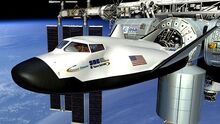(cleanup) Tag: sourceedit |
No edit summary |
||
| Line 48: | Line 48: | ||
Shuttles and shuttle-launches come in a staggering range of designs, as they are often built on planetary surfaces and either flown (if shuttles) or ferried (aboard larger orbiters) to orbit for sale or installation. |
Shuttles and shuttle-launches come in a staggering range of designs, as they are often built on planetary surfaces and either flown (if shuttles) or ferried (aboard larger orbiters) to orbit for sale or installation. |
||
| − | The vast majority of shuttles and shuttle-launches in the [[Frontier Sector|Frontier]] are [[hull size]] 2, with a small, but significant percentage of HS-1 seen throughout the Frontier, often in private hands, milling to and fro most space stations. Very few true “shuttles” are HS-3, |
+ | The vast majority of shuttles and shuttle-launches in the [[Frontier Sector|Frontier]] are [[hull size]] 2, with a small, but significant percentage of HS-1 seen throughout the Frontier, often in private hands, milling to and fro most space stations. Very few true “shuttles” are HS-3, as these are most often orbiters; ships in their own right, though some HS-3 shuttles are seen serving the route between the stations of [[Gran Quivera]]. |
Most ships carry their shuttles externally (see “[[Shuttle#Lifeboats|Lifeboats]]”, below), though some dedicate internal space to them. |
Most ships carry their shuttles externally (see “[[Shuttle#Lifeboats|Lifeboats]]”, below), though some dedicate internal space to them. |
||
Revision as of 14:14, 21 August 2018
Shuttles are simple spacecraft[1] designed to carry passengers and freight from one place to another - usually between ships and stations, or stations and planets. While functionally the same, Shuttles are designed for trans-atmospheric flight to and from a planetary surface, while Shuttle-Launches are designed for transport between ships or between a ship and a station.

Their chemical drives and small size limit their range, though they are capable of coasting long distances and shuttles are equipped with wings that allow for atmospheric gliding.[2]
Shuttles and shuttle-launches come in a staggering range of designs, as they are often built on planetary surfaces and either flown (if shuttles) or ferried (aboard larger orbiters) to orbit for sale or installation.
The vast majority of shuttles and shuttle-launches in the Frontier are hull size 2, with a small, but significant percentage of HS-1 seen throughout the Frontier, often in private hands, milling to and fro most space stations. Very few true “shuttles” are HS-3, as these are most often orbiters; ships in their own right, though some HS-3 shuttles are seen serving the route between the stations of Gran Quivera.
Most ships carry their shuttles externally (see “Lifeboats”, below), though some dedicate internal space to them.
Launches
Unlike “shuttle-launches”, Launches are a specific type of vehicle[3] commonly carried aboard space stations and passenger liners.
A launch is a small "space car" that is powered by a rocket engine. It is very short-ranged, and is used primarily to travel from one ship to another nearby ship or station. Launches can be purchased in two sizes: four-passenger and ten-passenger; both types have the same acceleration and handling characteristics.
A launch travels like a rocket pack, but a launch can carry 40 bursts of fuel. Characters inside a launch do not need to wear suits, as the cabins are fully pressurized and carry enough oxygen to support a full load of passengers for 10 hours.
Launches are unarmed, but characters can fire small arms from a launch if the canopy is open. [4]
Launches have no airlocks, so the only means of entering or leaving one is through the bubble canopy. In the launch dock of a ship or station, this bubble opens into the pressurized atmosphere of the ship. Once the launch is in space, however, a character cannot enter the launch without opening the bubble and exposing any passengers not in spacesuits to instant death.
If characters are hurriedly evacuating a ship, they can enter the launch at the rate of one character per turn (six seconds). The first character in can start the engines and begin releasing the docking restraints. The launch may take off five turns after the first character has entered it.
All Spacefleet ships of Assault scout type or larger carry a small launch. Cruisers and larger ships will have several small launches and a large launch.[5] Most space stations maintain a complement of launches of both sizes.
Lifeboats

Lifeboats are emergency, one-way shuttles.[6] One lifeboat can be carried by a ship for every 5 points of the ship's hull size.[7]
A lifeboat can carry up to 20 passengers for 30 hours, or 10 passengers for 60 hours. Unlike escape pods a lifeboat can be steered toward any objective the pilot chooses. It will travel 60,000 kilometers per hour with no acceleration, but it has unlimited maneuverability. If the lifeboat is not able to reach a planet, station, or other ship within the time listed above, the passengers will die from lack of air. The lifeboat will continue to travel in a straight line from that point until something interrupts its course.
The cost of a lifeboat is 100,000 credits. They are available at all types of spaceship construction centers.[8]
Lifeboats carry a number of survival kits for use in the event of landing on an uninhabited, potentially dangerous world.[9]
Lifeboats are somewhat large, so only ships comparable in size to a frigate or larger may carry one.[10] A lifeboat or externally-carried shuttle takes up one of the carrying ship’s hatches.
Escape Pods
Escape Pods are small, one-passenger lifeboats that can be launched from a ship towards any near-by planet, space station, or ship. The pod must be given a target when it is launched. This target cannot be changed after launch, because the pod has no steering controls, being entirely automated. Pods also carry automatic S.O.S. beacons that can be turned on or off by the passenger.
An escape pod travels 1 million kilometers every 10 hours. It's life support system will support one passenger for 11 days (220 hours). After that, the passenger will suffocate.
A ship can carry a number of pods equal to its hull size. Escape pods cannot be mounted in fighters, but fighters can be modified so that the entire cockpit is ejected.[11]
Each escape pod costs 30,000 credits.
Advanced Lifeboats and Escape Pods[12]
Advanced versions of both Lifeboats and Escape pods exist that reduce active life support to a minimum in favor of extending potential survival time indefinitely by placing passengers into stasis, making them the equivalent of Storage Class passengers.
Assault Shuttles
Assault Shuttles[13] are large military trans-atmospheric shuttles (hull size 2). They are usually carried on assault transports in large numbers, or at least one on a large warship. They can each carry one or more ground vehicles, an APC with internal ground troops, or just ground troops. In a planetary assault, these ships would move back and forth between Assault Carrier and planet to offload ground forces to the staging areas. Once the initial deployments are accomplished, these shuttles are used to resupply or reinforce the ground forces.
Better armored that a typical shuttle, AS’s always have aircar-like movement capability and commonly dead-stick into the atmosphere with a full load of fuel, gliding toward the target before engaging the VTOL atmospheric drives and delivering its payload. After this, the shuttle VTOLs away, climbing as high as possible before engaging its rockets to rendezvous with its mothership in orbit, where it is refueled, recharged and reloaded for another trip.
"Digger" Shuttles
A digger shuttle can be used on asteroids or small moons that have less than .1g gravity. A digger shuttle is essentially a HS-2 shuttle equipped with an automatic digging apparatus on it's nose. It can scoop mined material into the shuttle's hold at the rate of 4 tons per hour. Up to 50 tons of material can be stored in the shuttle's hold before it must return to the mining ship or other processing center for unloading.[14]
Notes
- ↑ No Piloting (skill) is required; a Technician-6 can fly one.
- ↑ Some shuttles are designed to operate as an Aircar while in atmosphere, sacrificing some of their cargo space for the capability.
- ↑ It is not designed according to the Ship Construction Rules in Knight Hawks.
- ↑ Of course, characters in a launch with an open canopy will die unless they are wearing spacesuits!
- ↑ Minimum Hull Size to carry a launch is HS: 3; each three Hull Units allow for one 4-passenger launch to be carried in a dedicated hatch, much like a Workpod. 10-passenger launches may be carried in place of one 4-passenger launch, but this decision must be made during ship construction.
- ↑ They can enter an atmosphere and glide to a landing, but cannot return to orbit on their own.
- ↑ Examples: an assault scout (HS=3) cannot carry a lifeboat, while a frigate (HS=5) or destroyer )HS=6) can carry a single lifeboat. A battleship (HS=20) can carry up to four lifeboats.
- ↑ Knight Hawks pp.17
- ↑ Star Frontiers Alpha Dawn "Crash on Volturnus" module
- ↑ One may be carried for every five hull sizes; HS: 1-4 = none, HS: 5-9 = 1, HS: 10-14 = 2, HS: 15-19 = 3, HS: 20 = 4.
- ↑ Knight Hawks pp. 17
- ↑ House Rule/Non-canon
- ↑ Let’s not call them “dropships” in order to retain a degree of uniqueness to this setting.
- ↑ Knight Hawks Campaign Book pp.20